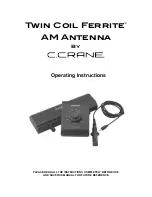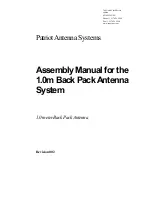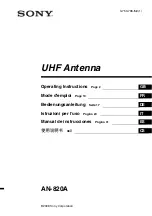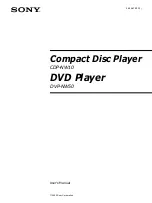
2
SITE SELECTION
The first and most important consideration when choosing a prospective antenna site is whether or not the area can provide an acceptable
“look angle” at the satellites. A site with a clear, unobstructed view is preferred. Also consider any obstruction that may occur in the future
such as the growth of trees. Your antenna site must be selected in advance so that you will be able to receive the strongest signal available.
To avoid obstructions, etc., conduct an on-site survey with a portable antenna. The satellite antenna can be installed on a ground pole, wall/
roof mount, or non-penetrating roof mount with 2-7/8” or 3” outside diameter mast. The chosen mount type should be assembled and in
place before installing the antenna. Refer to instructions packed with mount for its proper installation. The mast pipe must be vertical and
plumb to insure ease of alignment.
As with any other type of construction, a local building permit may be required before installing an antenna. It is the property owner’s
responsibility to obtain any and all permits.
Before any digging is done, information regarding the possibility of underground telephone lines, power lines, storm drains, etc., in the
excavation area should be obtained from the appropriate agency.
Because soils vary widely in composition and load capacity, consult a local professional engineer to determine the appropriate foundation
design and installation procedure. A suggested foundation design with conditions noted is included in this manual for reference purposes
only.
GROUND POLE INSTALLATION
7.3 cm or 7.6 cm
(2.88” or 3.00” O.D.)
91.4 cm max.
(36”)
1
82.9 cm
(72”)
102 cm
(40”)
#3 rebar
x diameter
of pier. Insert through
hole in tube and center.
#3
Re
ba
r
D
Minimum
Diameter
25 mm
to 51 mm
(1” to 2”) slope
for water run-off
Grade
Below
Frost Line
182.9 cm
(72”)
25 mm to 51 mm (1” to 2”)
slope for water run-off
Grade
7.3 cm or 7.6 cm
(2.88” or 3.00” O.D.)
D
Minimum
Diameter
Below
Frost Line
Approx.
51 mm
(2”)
127 cm
(50”) (See Note)
#3 rebar x .46 m (18”)
Insert through
hole in tube and center.
#3
Re
ba
r
#3 rebar x .6 m (24”)
at 60˚ apart (See note)
51 mm
(2”)
Bubble
Level
Ground Pole Must Be
Vertical in All Directions
at Top
NOTE:
127 cm (50”) may
be increased to frost
line. Concrete and
length of rebar will
increase
accordingly.
Bottom View
91.4 cm max.
(36”)
Pier Foundations
Deep Frost Line Foundations
1.2 m
Antenna
Pier Foundations
Deep Frost Line Foundations
WIND VEL
DIME D
CONC VOL
DIM D
CONC VOL
DIM D CONC VOL
DIM D
CONC VOL
GROUND
km/h (mph)
cm (in)
m3 (ft3)
cm (in)
m3 (ft3)
cm (in) m3 (ft3)
cm (in)
m3 (ft3)
POLE
161 (100)
30 (12)
0.08 (2.9)
46 (18)
0.18 (6.5)
20 (8) 0.05 (1.6)
33 (13)
0.12 (4.2)
A ,B or C
201 (125)
43 (17)
0.17 (5.9)
61 (24)
0.33 (11.5)
30 (12) 0.10 (3.6)
48 (19)
0.25 (9.0)
C
EXPOSURE B
EXPOSURE C
EXPOSURE B
EXPOSURE C
POLE SPECIFICATIONS:
Ground Pole “A”
2-1/2 Schedule 40 Steel ASTM A53 Pipe (73 mm x 5 mm Wall/2.88” OD x .203” Wall)
Ground Pole “B”
3.0” OD x 9 Gauge (.148” Wall) Steel ASTM A501 Pipe (76 mm OD x 3.8 mm Wall)
Ground Pole “C”
2-1/2 Schedule 80 Steel ASTM A53 Pipe (73 mm x 7 mm Wall/2.88” OD x .276” Wall)




























